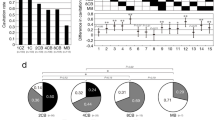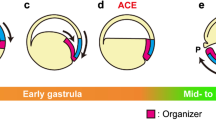Summary
UsingAmbystoma mexicanum blastulae (Harrison 7 2/3 to 10−), a study was made of the morphogenetic behaviour of the endoderm, both in isolation and upon recombination with marginal zone material.
It was shown that the endoderm autonomously forms “flask cells” and thus a blastoporal groove, when isolated at or after the mid-blastula stage (8+). The frequency of blastopore formation decreases as the endoderm is isolated at successively younger stages. At the youngest operable stage (7 2/3) a blastoporal groove is formed in 30% of the isolates.
Recombination with marginal zone material promoted blastopore formation in endoderm isolated at stage 7 2/3; the frequency of blastopore formation was maximal (90%) in recombinates with dorsal marginal zone from stages 7 2/3 and 8 1/2, while in recombinates with older dorsal (stages 9 and 10−) or with ventral marginal zone (stages 7 2/3 to 10−) it was lower (60%). Blastopore formation could only be evoked on the dorsal side of the endoderm.
Ventral halves of stage 10− endoderm are unable to form flask cells, whereas the complete endoderm forms flask cells ventrally as well as dorsally, demonstrating the leading role of the dorsal endoderm in flask cell formation.
Only the left half of the dorsal or ventral marginal zone was used in the recombinates, the corresponding right half being culturedin vitro. Differentiation of mesoderm in these control explants was used as a criterion for the presence of induced mesoderm in the marginal zone material at the time of recombination. Differentiation was poor, however, which affects the reliability of this criterion. No relation could be found between the presence of induced mesoderm in the isolated marginal zone material and the incidence of gastrulation phenomena in the endoderm/marginal zone recombinates.
Thus the results of these experiments provide no evidence for a gastrulation-inducing role of the induced mesoderm, as proposed by Nieuwkoop (1969a). Alternatively, the results suggest that the endoderm may acquire its capacity for blastopore formation as a direct consequence of the earlier dorso-ventral polarization of the embryo, without the intervention of the induced mesoderm. Synchronization of endodermal and mesodermal gastrulation movements must be established during mesoderm induction.
Similar content being viewed by others
References
Bachvarova, R., Davidson, E. H., Alfrey, V. G., Mirsky, A. E.: Activation of RNA synthesis associated with gastrulation. Proc. nat. Acad. Sci. (Wash.)55, 358–365 (1966a).
Bachvarova, R., Davidson, E. H.: Nuclear activation at the onset of amphibian gastrulation. J. exp. Zool.163, 285–296 (1966b).
Baker, P.: Fine structure and morphogenetic movements in the gastrula of the treefrogHyla regilla. J. Cell Biol.24, 95–116 (1965).
Balinsky, B. I.: Ultrastructural mechanisms of gastrulation and neurulation. In: Symposium on Germ Cells and Development. Pallanza sept. 14–20, 1960, p. 205–219. Milano: A. Baselli 1961.
Ban-Holtfreter, H.: Differentiation capacities of Spemann's organizer investigated in explants of diminishing size. Thesis, University of Rochester 1965.
Brice, M. C.: A re-analysis of the consequences of frontal and sagittal constrictions of newt blastulae and gastrulae. Arch. Biol. (Liège)69, 371–439 (1958).
Chibon, P., Brugal, G.: Etude autoradiographique de l'action de la temperature et de la thyroxine sur la durée des cycles mitotiques dans l'embryon âgé et la jeune larve dePleurodeles waltlii Michah. (amphibien urodèle). C. R. Acad. Sci. (Paris)269, 70–73 (1969).
Dalcq, A.: Expériences de transplantation, de translocation et d'ablation relatives à la détermination du système nerveux primitif chez les amphibiens. C. R. Soc. Biol. (belge)114, 159–163 (1933).
Dalcq, A.: Recent experimental contributions to brain morphogenesis in amphibians. 6th Growth Symposium. 85–119 (1947).
Davidson, E. H., Crippa, M., Mirsky, A.: Evidence for the appearance of novel gene products during amphibian blastulation. Proc. nat. Acad. Sci. (Wash.)60, 152–159 (1968).
Detlaff, T. A.: Cell divisions, duration of interkinetic states and differentiation in early stages of embryonic development. Advanc. Morphogenes.3, 323–362 (1964).
Dollander, A.: Etudes des phénomènes de régulation consécutifs à la séparation des deux premiers blastomères de l'œuf deTriton. Arch. Biol. (Liège)61, 1–111 (1950).
Ecker, R. E., Smith, L. D.: The nature and fate ofR. pipiens proteins synthesized during maturation and early cleavage. Develop. Biol.24, 559–576 (1971).
Flickinger, R. A., Daniel, J. C., Greene, R. F.: Effect of rate of cell division on RNA synthesis in developing frog embryos. Nature (Lond.)228, 557–559 (1970).
Gilchrist, F. G.: Gastrulation in thermal gradient treated eggs ofTriturus torosus. Anat. Rec.47, 330 (1930).
Gilchrist, F. G.: The time relations of determinations in early amphibian development. J. exp. Zool.66, 15–51 (1933).
Goerttler, K.: Experimentell erzeugte „Spina bifida“ und „Ringembryobildungen“ und ihre Bedeutung für die Entwicklungsphysiologie der Urodeleneier. Z. Anat. Entwickl.-Gesch.80, 283–341 (1926).
Harrison, R. G.: Harrison stages and description of the normal development of the spotted salamanderAmblystoma punctatum (Linn.). In: Organization and development of the embryo, ed. S. Wilens, p. 44–66. London-New Haven: Yale University Press 1969.
Hoessels, E. L. M. J.: Evolution de la plaque préchordale d'Ambystoma mexicanum; sa differentiation propre et sa puissance inductrice pendant la gastrulation. Thesis, Utrecht 1957.
Holtfreter, J.: Potenzprüfungen am Amphibienkiem mit Hilfe der Isolationsmethode. Verh. dtsch. zool. Ges. 158–166 (1931).
Holtfreter, J.: Differenzierungspotenzen isolierter Teile der Urodelengastrula. Wilhelm Roux' Arch. Entwickl.-Mech. Org.138, 522–656 (1938).
Holtfreter, J.: Studien zur Ermittlung der Gestaltungsfaktoren in der Organentwicklung der Amphibia. II. Dynamische Vorgänge an einigen mesodermalen Organanlagen. Wilhelm Roux' Arch. Entwickl.-Mech. Org.139, 227–271 (1939).
Holtfreter, J.: A study of the mechanics of Gastrulation. I: Morphogenetic tendencies of ectodermal germ layers. J. exp. Zool.94, 261–319 (1943).
Ikushima, N.: Kinetic properties of the marginal zone of the amphibian egg in relation to the histological differentiation. Mem. Coll. Sci., Univ. Kyoto Series B25, 145–160 (1958).
Ikushima, N.: Formation of notochord in an explant derived from the dorsal marginal zone of the early gastrula of amphibia. Jap. J. Zool.13, 117–139 (1961).
Ikushima, N., Maruyama, S.: Structure and developmental tendency of the dorsal marginal zone in the early amphibian gastrula. J. Embryol. exp. Morph.25, 263–276 (1971).
Nakamura, O.: Differentiation during cleavage and nucleocytoplasmic interactions. Ann. Embryol. Morphogen., Suppl.1, 261–262 (1969).
Nakamura, O., Matsuzawa, T.: Differentiation capacity of the marginal zone in the morula and blastula ofTriturus pyrrhogaster. Embryologia (Nagoya)9, 223–237 (1967).
Nakamura, O., Takasaki, H.: Further studies on the differentiation capacity of the dorsal marginal zone in the morula ofTriturus pyrrhogaster. Proc. Japan Acad.46, 546–551 (1970a).
Nakamura, O., Takasaki, H., Mizohata, T.: Differentiation during cleavage inXenopus laevis. I. Acquisition of self-differentiation capacity of the dorsal marginal zone. Proc. Japan Acad.46, 694–699 (1970b).
Nieuwkoop, P. D.: The formation of the mesoderm in urodelean amphibians. I. Induction by the endoderm. Wilhelm Roux' Archiv162, 341–373 (1969a).
Nieuwkoop, P. D.: The formation of the mesoderm in urodelean amphibians. II. The origin of the dorso-ventral polarity of the mesoderm. Wilhelm Roux' Archiv163, 298–315 (1969b).
Nieuwkoop, P. D.: The formation of mesoderm in urodelean amphibians. III. The vegetalizing action of the Li-ion. Wilhelm Roux' Archiv166, 105–123 (1970).
Nieuwkoop, P. D., Faber, J.: Normal table ofXenopus laevis (Daudin); 2nd ed. Amsterdam: North Holland Publ. Co. 1967.
Nieuwkoop, P. D., Florschütz, P. A.: Quelques caractères spéciaux de la gastrulation et de la neurulation de l'œuf deXenopus laevis Daud. et de quelques autres anoures. 1e partie Etude déscriptive. Arch. Biol. (Liège)61, 113–150 (1950).
Nieuwkoop, P. D., Ubbels, G. A.: The formation of the mesoderm in urodelean amphibians. IV. Qualitative evidence for the purely “ectodermal” origin of the entire mesoderm and of the pharyngeal endoderm. Wilhelm Roux' Archiv169, 185–199 (1972).
Ôgi, K.-I.: Determination in the development of the amphibian embryo. Sci. Rep. Tôhoku Univ. Ser. 4 Biol.33, 239–247 (1967).
Ôgi, K.-I.: Regulative capacity in the early amphibian embryo. Res. Bull. Dept. gen. Educ. Nagoya Univ.13, 31–40 (1969).
Okada, T. S.: The pluripotency of the pharyngeal primordium in urodelan neurula. J. Embryol. exp. Morph.5, 438–449 (1957).
Okada, Y. K., Ichikawa, M.: A new normal table of the development ofTriturus pyrrhogaster. Exp. Morph. (Tokyo)3, 1–6 (1947).
Perry, M. M.: Tubular elements associated with yolk platelets inTriturus alpestris. J. Ultrastruct. Res.16, 376–381 (1966).
Perry, M. M., Waddington, C. H.: Ultrastructure of the blastopore cells in the newt. J. Embryol. exp. Morph.15, 317–330 (1966).
Romeis, B.: Mikroskopische Technik, 15. Aufl. München: R. Oldenbourg Verlag 1948.
Ruffini, A.: Contributo alla conoscenza della ontogenesi degli Anfibi anuri ed urodeli. Arch. Anat. Embriol. (Firenze)6, 129–157 (1907).
Ruud, G.: Die Entwicklung isolierter Keimfragmente frühester Stadien vonTriton taeniatus. Wilhelm Roux' Archiv Entwickl.-Mech. Org.105, 209–293 (1925).
Schechtman, A. M.: The mechanism of amphibian gastrulation. I. Gastrulation-promoting interactions between various regions of an anuran egg (Hyla regilla). Univ. Calif. Publ. Zool.51, 1–40 (1942).
Skoblina, M. N.: A dimensionless characteristic of the duration of the mitotic phases in the first segmentation divisions in Axolotl. Dokl. Akad. Nauk. SSSR160, 700–703 (1965) (English translation).
Snedecor, G. W., Cochran, W. G.: Statistical methods, 6th ed. Ames, Iowa: Iowa State University Press 1967.
Spemann, H.: Entwicklungsphysiologische Studien am Triton-Ei. 1, 2. Arch. Entwickl-Mech. Org.12, 224–262 (1901).
Speman, H.: Entwicklungsphysiologische Studien am Triton-Ei. 3,4,5. Arch. Entwickl.-Mech. Org.15, 448–534 (1902).
Spemann, H.: Über die Determination der ersten Organanlagen des Amphibienembryo I–VI. Arch. Entwickl.-Mech. Org.43, 449–555 (1918).
Spemann, H.: Über den Anteil von Implantat und Wirtskeim an der Orientierung und Beschaffenheit der induzierten Embryonalanlage. Wilhelm Roux' Archiv Entwickl.-Mech. Org.123, 389–517 (1931).
Spemann, H., Mangold, H.: Über Induktion von Embryonalanlagen durch Implantation artfremder Organisatoren. Arch. mikrosk. Anat.100, 599–638 (1924).
Sudarwati, S., Nieuwkoop, P. D.: Mesoderm formation in the anuranXenopus laevis (Daudin). Wilhelm Roux' Archiv166, 189–204 (1971).
Stableford, L. T.: The potency of the vegetal hemisphere of theAmblystoma punctatum embryo. J. exp. Zool.109, 385–426 (1948).
Takata, Ch.: The differentiation in vitro of the isolated endoderm under the influence of the mesoderm inTriturus pyrrhogaster. Embryologia (Nagoya)5, 38–70 (1960).
Valouch, P., Melichna, J., Sladeček, F.: The number of cells at the beginning of gastrulation depending on temperature in different species of Amphibians. Acta Univ. Carol. Biol. 195–205 (1970).
Vintemberger, P.: Résultats de la suppression du blastopore, chezRana fusca, par irradiation localisée à l'hémisphère inférieur de la blastula et théorie de l'origine blastoporale du dos de l'embryon. C. R. Soc. Biol. (Paris)112, 809–812 (1933a).
Vintemberger, P.: Sur les résultats de la déstruction par irradiation localisée de deux ou des quatre macromères du stade à huit cellules, dans l'œuf deRana fusca. C. R. Soc. Biol. (Paris)112, 1083–1085 (1933b).
Vintemberger, P.: Résultats de l'auto-différenciation des quatre macromères isolés au stade de huit blastomères dans l'œuf d'un amphibien anoure. C. R. Soc. Biol. (Paris)117, 693–695 (1934a).
Vintemberger, P.: Sur les résultats du développement des quatre micromères isolés au stade de huit blastomères dans l'oeuf d'un amphibien anoure. C. R. Soc. Biol. (Paris)118, 52–53 (1934b).
Vintemberger, P.: Sur le développement comparé des micromères de l'œuf deRana fusca divisé en huit: (a) après isolement, (b) après transplantation sur un socle de cellules vitellines. C. R. Soc. Biol. (Paris)122, 927–930 (1936).
Vogt, W.: Gestaltungsanalyse am Amphibienkeim mit örtlicher Vitalfärbung. II. Teil. Gastrulation und Mesodermbildung bei Urodelen und Anuren. Wilhelm Roux' Archiv Entwickl.-Mech. Org.120, 384–706 (1929).
Woodland, H. R., Gurdon, J. B.: The relative rates of synthesis of DNA, sRNA and rRNA in the endodermal region and other parts ofXenopus laevis embryos. J. Embryol. exp. Morph.19, 363–385 (1968).
Woodland, H. R., Gurdon, J. B.: RNA synthesis in an amphibian nuclear transplant hybrid. Develop. Biol.20, 89–104 (1969).
Author information
Authors and Affiliations
Additional information
Aided by a grant from the Netherlands Organization for the Advancement of Pure Research (Z.W.O.).
I am much indebted to Professor P. D. Nieuwkoop, for suggesting the problem and for his continuous interest and stimulating advice. I am grateful to drs. K. A. Lawson and J. Faber for critically reading the manuscript.
Rights and permissions
About this article
Cite this article
Doucet-de Bruïne, M.H.M. Blastopore formation inAmbystoma mexicanum . W. Roux' Archiv f. Entwicklungsmechanik 173, 136–163 (1973). https://doi.org/10.1007/BF00575139
Received:
Issue Date:
DOI: https://doi.org/10.1007/BF00575139




